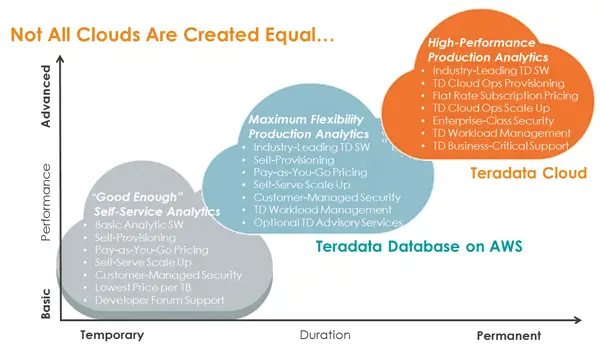Teradata has announced that it is bringing its Teradata Database data warehousing and analytics platform to the public cloud on Amazon Web Services. The move is a direct reaction to customer requests to bring the analytics platform to the cloud of their choice and provides customers with the option to adopt Teradata’s analytics services in a self-service cloud environment with pay-as-you-go pricing.
With the AWS offering, Teradata is looking to make its software more widely accessible to new customers, lower the barriers to entry, enable closer proximity to data sources and provide customers with easier scalability. In particular, the scalability with AWS allows for easier handling of peak workloads with hourly billing, differentiating the public cloud offering from Teradata Cloud.
Two years ago, Teradata opened up its Teradata Database and Teradata Aster Discovery Platform and made them available under the name Teradata Cloud. Teradata Cloud is a flat-rate subscription service that is intended to offload installation and maintenance of a Teradata implementation on premises. It maintains the same mission-critical level of service as an on-site implementation without the capital investments. Teradata Cloud includes enterprise-class security managed by Teradata along with services from the company to help setup and configure the environment. The appeal of a flat-rate cloud service is unlimited consumption. But for many customers, unlimited was beyond their requirements.
Teradata on Amazon Web Services allows a customer to order Teradata Database directly from the Amazon control panel and scale it accordingly within AWS. Unlike the Teradata Cloud offering, Teradata on AWS is intended for the customer who wants to take more responsibility for their cloud offering, for instance, the customer is responsible for tasks like security of the environment. But it offers much more flexibility to the customer to size the environment and pay only for what they consume.

The AWS capabilities joins Teradata’s existing cloud offering within the Teradata Cloud and will be made available during the first quarter of 2016.

